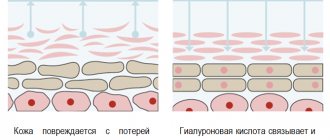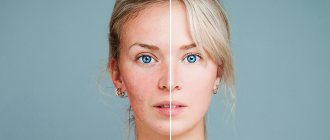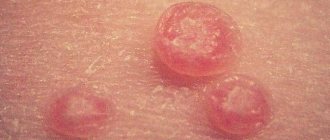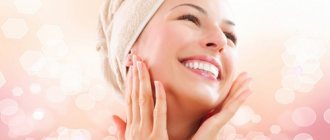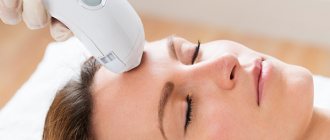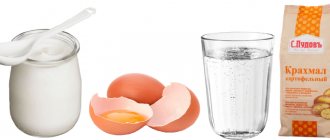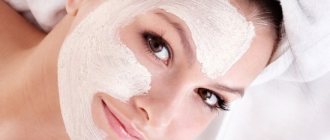Rosacea is one of the common dermatoses. It manifests itself as pink rashes, sometimes pustules, and vascular changes. Rosacea is a disease of polyetiological nature. It is most often observed in people aged 30–40 years, and reaches its maximum severity by 40–50 years. However, in the last decade it has often been diagnosed in children and adolescents due to the development of acne.
In the initial stages of rosacea, minor redness periodically occurs in the forehead, cheeks, nose and chest. It can be diagnosed visually by a doctor and is quite easy to treat. In moderate and severe forms, the disease is much more difficult to treat, so early diagnosis and timely therapy are important.
Rosacea Treatment Methods
Dermatocosmetologists have a large number of different methods of treating this disease at their disposal.
To obtain a lasting clinical result, our clinic’s specialists use a combination of several methods of therapy, including medicinal (drugs) and “local” (ointments and gels).
Modern non-drug methods for treating rosacea include cryotherapy with liquid nitrogen, photo- and laser destruction, and destruction of blood vessels using a high-intensity broadband light source IPL systems.
One of the promising modern methods of treating rosacea, which has shown high efficiency, is plasma therapy (the use of autologous plasma with a high platelet content).
Physiotherapeutic methods for treating rosacea
Cryotherapy or cryo massage
The essence of treating rosacea using cryotherapy is that the patient’s skin is exposed to liquid nitrogen, the temperature of which is -196 degrees. Due to this, when nitrogen comes into contact with the surface layers of the epidermis, a reflex narrowing of the capillaries occurs, which subsequently begin to expand in the same way. Such processes lead to a sharp increase in blood supply to the skin, a decrease in inflammatory processes and an increase in metabolism. It has also been proven that such cryo massage stimulates facial muscles and, as a result, the skin becomes elastic and the face takes on the correct shape. The recommended number of courses should be at least 20.
Electrophoresis
To carry out electrophoresis, use ascorbic acid, any antihistamine (anti-allergic) and aloe extract. To achieve a lasting cosmetic effect, it is necessary to carry out at least 30 procedures daily for one month.
Laser therapy
Laser therapy for rosacea is considered one of the most effective physiotherapeutic treatments. Its essence is that when a laser beam interacts with the manifestations of this disease (papules, pustules, erythema, etc.), a sharp heating of the skin occurs in a certain area. This leads to coagulation of these manifestations, sterilization, improvement of blood flow and stimulation of facial muscles. The laser effect also causes the rapid replacement of old or disease-damaged surface skin cells with new ones. It should be noted that excellent results are achieved both in the acute and remission stages. Cosmetologists recommend carrying out such procedures for at least 2 weeks.
Sobby massage
This type of massage is performed quite gently and painlessly. Its advantage is the improvement of drainage of the local lymphatic system and improvement of capillary blood flow on the facial skin. Massage according to Sobby is strictly prohibited for pustular rosacea.
IPL phototherapy
The essence of this method is to expose skin cells to an infrared ray in the wave range from 515 to 1200 nm, which comes into contact with chromophores, that is, substances that absorb light and are part of the structure of every cell in the body, as a result of which they begin to heat up to a certain temperature. It should be noted that the main chromophores include the skin pigment - melanin and the blood protein that carries oxygen - hemoglobin. This infrared beam, unlike a laser, penetrates inside without damaging the surface layers. The use of this method for rosacea provides long-term remission and renewal of the epidermis. IPL phototherapy is carried out over just a few minutes, but the number of sessions is determined individually.
Health care
Impact with antibiotics
The most complex and advanced cases of rosacea respond well to medication. Your doctor should prescribe tetracycline antibiotics in tablet form, such as erythromycin, ornidazole, metronidazole, and doxycycline. They have a strong antibacterial effect and help quickly stop the inflammatory process.
Hardware cosmetology
There are hardware methods for treating rosacea, such as laser therapy, electrocoagulation, and dermabrasion. These procedures include a deep cleansing of the skin, they remove the affected areas, preventing the disease from spreading. The procedures also activate immune processes, improve rejuvenation and blood circulation, helping the facial skin overcome inflammation. The laser also has an antibacterial effect and helps treat facial skin from rosacea. Dermabrasion is performed once, while laser therapy and electrocoagulation require several sessions.
We apply and treat
Ointments show effective results. It is advisable to consult a doctor before starting to use them. The most effective are: zinc ointment, gels and ointments, which contain metronidazole, adapalene, azelaic acid and other bactericidal substances. For example, sulfacetamide, metrogel, rozamet. They help fight irritation and redness of the skin, do not allow the inflammatory process to develop, the ointment must be applied 1-2 times a day, depending on the degree of damage to the facial skin.
help yourself
Beauty and health mask
External treatment of inflamed facial skin with rosacea can be carried out at home using folk remedies. The most popular method is masks, which help reduce irritation, relieve swelling, and reduce inflammation.
A mask made from oatmeal gives a good effect; it perfectly nourishes and cleanses the skin, relieves irritation. A kefir mask helps restore and improve the functioning of the sebaceous glands, and a mask made from aloe leaves can dry out your face. A mask made from apple pulp moisturizes and soothes the skin; you can add oatmeal or kefir to it. A mask made from fresh cucumbers moisturizes the face and fills the skin with vitamins, improving the functioning of the skin glands.
Therapeutic diet
Since rosacea very often occurs in connection with poor nutrition, establishing a proper diet is one of the primary tasks. You will have to exclude alcohol from the menu, especially red wine, and you will need to reduce the amount of sugar and fat you consume. The diet should contain more dietary fiber, which improves blood circulation and helps the skin stay healthy, so you need to include a large amount of plant foods and probiotics in your food. For high-quality cleansing and moisturizing of the skin, which helps it strengthen its immunity, you need to drink more clean water.
Essential Help
In the treatment of rosacea, essential oils such as lavender, tea tree, and jojoba oil have a good effect. They have a powerful antiseptic and anti-inflammatory effect. Oils can be added to base oil and applied to the face in the form of lotions; you can also rub a little diluted oil into the affected areas of the skin.
Vitamin therapy
In case of illness, it is important to provide the body with the necessary resources to fight the damage. It is important in this case to take vitamins; the most beneficial for facial skin with rosacea are vitamins A, E, C and B, they help strengthen the immune system and activate regeneration processes.
Outdoor assistance
Compresses, like masks, have a good healing effect. A compress made from a decoction of chamomile, green tea and calendula perfectly helps improve the condition of facial skin and has an antiseptic effect.
Have you encountered the problem of rosacea on your face? What treatment helped you? Have you found out the cause of this disease? We are waiting for your feedback and comments!
Folk remedies for treating rosacea can help relieve inflammation, irritation, itching and improve skin condition. Rosacea is a chronic skin disease. Rosacea affects both women and men. This disease is common throughout the world and, according to WHO estimates, about 45 million people suffer from it.
Acne and rosacea are often mistaken for rosacea. Although this is not entirely true. The main signs of rosacea are red or pink skin, small dilated blood vessels, and small red bumps that sometimes contain pus. Rosacea can also affect the eyes – ocular rosacea. Most people with rosacea have very sensitive skin that becomes red and flaky.
It can have a period of remission and exacerbation. Rosacea mainly affects the central part of the face, cheeks, forehead, chin, around the nose, and most often the lower part.
Rosacea is considered an incurable disease. Treatment can only reduce the symptoms of rosacea and prolong the period of remission. In addition to medication treatment options, proven home remedies for rosacea can be used to reduce the appearance of rosacea, its symptoms and flare-ups.
Folk remedies for treating rosacea include:
Cold compresses on the affected area;
Additional care in the form of masks;
Use of natural cosmetics and creams based on them.
Hardware treatment methods
Ultrasonic skin cleansing for rosacea can provide long-term remission without causing any complications from the internal organs. When an infection occurs, a highly effective technique is ultrasonic cavitation. Mesotherapy and ozone therapy are also considered the main methods of combating rosacea. The essence of this treatment is that an ozone-oxygen mixture is introduced into the skin using injections, which can be supplemented with various vitamins and antioxidants. Ozone therapy is carried out at least 3 times a week for several weeks. It is important to note that ozone and mesotherapy are contraindicated in acute inflammation and pustular formrosacea.
What diet does rosacea suggest?
Diet for rosacea is an important part of the comprehensive treatment of the pathology.
Basic principles:
- Frequent meals in small portions. This stimulates metabolism and teaches the stomach to quickly become full.
- Drink plenty of fluids: clean water, weak, non-hot tea, herbal decoctions, fresh diluted juices.
What not to eat
In order not to worsen the clinical picture, it is necessary:
To prevent red pimples from forming on the face after successful treatment, it is recommended to follow a certain diet. To do this, you should avoid hot, spicy, salty foods, alcohol and coffee.
Citrus fruits, grapes, and pears remain prohibited. To consolidate the effect, the doctor may prescribe therapeutic fasting, during which mineral water is drunk for the first 2 days, and then the usual food begins to be included in the menu.
Post Views: 3,779
Drug treatment for rosacea
Treatment of rosacea with antibacterial drugs For these purposes, tetracycline drugs, macrolides (erythromycin and azithromycin) and inidazoles (metronidazole) are used. It should be noted that all antibacterial drugs are used orally and for a long time (up to about 2 months). Treatment with antihistamines Among the main antihistamines, their representatives of the 3rd and 4th generations are widely used. Such medicines can be used both in tablet form and in the form of ointments. Antihistamines for rosacea are often used in combination with hardware and other treatment methods. Additionally, during periods of exacerbations, steroidal anti-inflammatory drugs are prescribed along the way.
Causes and symptoms of rosacea
There are three stages of this disease:
- light form;
- medium shape;
- rosacea in severe form.
Each stage has its own clinical picture and symptoms.
In the first case, facial redness may be subtle and short-lived, in which case rosacea is often mistaken for a healthy glow, especially since the redness mainly appears on the cheeks and forehead.
Signs of the second stage include clear and persistent hyperemia (overflow of blood vessels), and in most cases a red acne appears on the face.
These rashes can quickly spread to the neck, chest and back. At the same time, the face swells greatly, the acne rashes itch and itch.
In the case of a severe form, seborrhea may develop, the rashes become even larger, the contours of the face change, and the nose, lips and ears may noticeably increase in size.
Important:
Alena Zernovitskaya, a famous blogger, shared her AUTHOR'S recipe for a youthful face mask, which she has been using for more than 5 years!
Read in full
Clinical intervention is necessary already at the second stage, but do not postpone a visit to the doctor even with slight redness, since regardless of the stage of the disease, there is a risk of eye damage.
There are cases where advanced rosacea has led to complete blindness.
